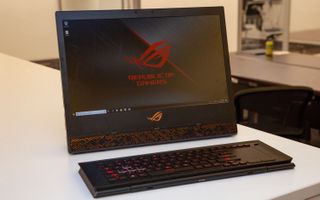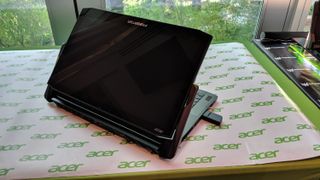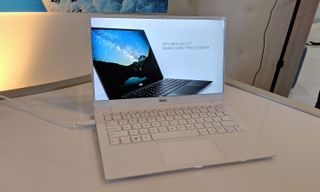What We Learned About the Future of Laptops at CES 2019
After a rousing CES 2019 in Las Vegas that unveiled a bunch of refreshes around Nvidia’s RTX graphics cards for laptops and Intel’s Whiskey Lake CPUs, laptops will be an exciting category in consumer tech in 2019.
And after a week looking at almost every laptop in Sin City, some major trends started to emerge. Here’s what to expect from laptops in 2019:
Desktop Replacements

Let it be known, the laptop has its knives out for the desktop. For those who don’t want to build their own, or just want an all-in-one solution that’s more portable than most desktop gaming rigs, some big gaming laptops are coming down the pipe. Notably, there’s the Alienware Area 51-m, a powerful laptop with a desktop processor and upgradeable graphics cards (though we’ve yet to see exactly how those will be sold and what compatibility will be like).
On the other side of that coin is the Asus ROG Mothership, a Surface Pro-style detachable that turns into a desktop monitor and separate keyboard. If a desktop isn’t for you, someone is releasing a giant laptop that might work for you.
Using Gaming Laptops for Everything Else

We heard it from laptop companies, we heard it from Nvidia, we heard it from Microsoft: gaming laptops aren’t just for gaming anymore. During Nvidia’s press conference, CEO Jensen Huang announced that the company’s RTX GPUs will work to to accelerate 3D modeling and animation programs, edit 6K video (8K video on desktops) and broadcast pro-quality streaming from a single PC.
Microsoft, at its partner device showcase, detailed specific laptops, like the Acer Predator Triton 900, that could be used by content creators. The Predator has a flip out hinge that can fold down into a tablet. When used with a pen, it could be a powerful video-editing or photo-editing laptop with an RTX GPU.
More AMD Options
AMD’s CES had a ton of announcements, including its 3000 U and H-series Picasso APUs. Asus’ new TUF Gaming lineup will rely on the those processors along with AMD’s mobile GPUs. Additionally, the company’s Athlon chips will show up in Chromebooks from HP and Acer. It wouldn’t be surprising to see more companies announce laptops with AMD’s CPUs this year, though Intel will likely continue to dominate the space for another year.
Stay on the Cutting Edge
Join the experts who read Tom's Hardware for the inside track on enthusiast PC tech news — and have for over 25 years. We'll send breaking news and in-depth reviews of CPUs, GPUs, AI, maker hardware and more straight to your inbox.
OLED and 240 Hz Screens

One of HP’s marquee announcements was the 15-inch Spectre x360 with an OLED display arriving in March. Others aren’t far behind. Dell suggested that its 15-inch devices, particularly under the Dell G Series and Alienware brands, could see OLED later this year. Razer also showed us a prototype Razer Blade 15 with an OLED display, suggesting that was something that could be coming in the future.
HP also said its Omen 15 gaming notebook will have a 240 Hz option, and other vendors followed. Razer showed us a similar prototype Razer Blade with a 240 Hz display.
Very Slight Redesigns

If it ain’t broke, why fix it? We’re not seeing any major redesigns thus far. Dell moved the XPS 13’s webcam above the display (thank heavens) and redesigned the hinge for easier opening, and that may have been the most radical redesign of the show on a consumer laptop. Lenovo’s ThinkPad lineup has some new materials, but otherwise similar designs.
Part of this may be because when designs get so good, there’s little need to iterate. But it’s also possible that delays from Intel have left new designs waiting in the wings for whenever Ice Lake finally hits. Additionally, Intel announced Project Athena, a new notebook design project similar to ultrabooks, but told us very little about it. Perhaps its new tiny Lakefield motherboard will be what enables new designs.
Andrew E. Freedman is a senior editor at Tom's Hardware focusing on laptops, desktops and gaming. He also keeps up with the latest news. A lover of all things gaming and tech, his previous work has shown up in Tom's Guide, Laptop Mag, Kotaku, PCMag and Complex, among others. Follow him on Threads @FreedmanAE and Mastodon @FreedmanAE.mastodon.social.
-
Giroro "CEO Jensen Huang announced that the company’s RTX GPUs will work to to accelerate 3D modeling and animation programs, edit 6K video (8K video on desktops) and broadcast pro-quality streaming from a single PC."Reply
So Nvidia announced that their GPUs... are GPUs, and also that you can use them to do normal GPU things.
That's good to know. I was actually worried the RTX line is so focused on turning specialized enterprise features into useless gimmicks that they might cut Graphics Processing out of their laptop chips entirely. -
Tanyac The problems with laptops is (a) cooling, (b) speed and (c) ease of upgrade/expandability and (d) cost.Reply
Almost no laptops come with NVme drives because of heat. I have an Acer laptop in which I put a Samsung NVMe drive. It throttles constantly causing program freezes crashes and lagging. SATA so far has been the only "recommended" drive.... so slow!
The HDDs are also poor performers. 5400 RPM. The reason I put a Samsung NVMe drive in my laptop was because it took nearly 5 minutes to become fully booted up and usable with Windows 10 Pro. Granted, it had all the Manufacturers bloatware installed, but that is still abysmal.
The cost of laptops here have increased by almost 40% in the last year. I expect they will increase by at least another 60% in 2019 due to memory, graphics, SSD and other shortages. CPUs possibly too...
My laptop cost me $1299 in January 2017. It's now $1799 for the same one.
A half-decent 17" laptop here will set you back $4000 AUD. I can build a far more superior performing desktop for 25% less than that with a 27" monitor that will run much cooler and be snappier and more responsive than a laptop.
Your upgrade options are extremely limited in laptops. Maybe a little extra memory, maybe a bigger hard drive, not much else. Not happy with your laptop? You can't just upgrade it an save on cost like you can with a desktop; you're up for major replacement cost. And selling second hand.. People want stuff for 10% of the purchase cost. A $2000 laptop will be lucky to get you $200 after 12 months.
For school and business work laptops are great. I don't see them as being "serious" gaming systems for quite some time, and never will they be affordable in Australia even if they do make the grade. Cooling is ALWAYS going to be an issue, which hinders how far manufacturers can push them.
I know I'm going to get down voted for this, but the "oooh... laptops are the thing right now, I've got to have one" mentality is just insane. -
Nintendork Dunno why they talk about the future of laptops when "new models" are still stuck with the horrible 16:9 aspect ratio. THAT IS FINE FOR TV's.Reply
Just see how many unused space is on that Asus Desktop replacement, portable AIO. -
cryoburner Reply
What wasted space? That space is there to keep the screen at a somewhat more ergonomic height, so that you're not having to look down near your hands. That Rog Mothership with the detachable keyboard actually seems like an interesting design for things like gaming, so that one doesn't have to crane their wrists in weird ways if they want to stay centered with the screen while gaming with the keyboard and a mouse. It's absolutely massive for a portable computer though, and probably not something most people would want to regularly carry with them anywhere.21679592 said:Dunno why they talk about the future of laptops when "new models" are still stuck with the horrible 16:9 aspect ratio. THAT IS FINE FOR TV's.
Just see how many unused space is on that Asus Desktop replacement, portable AIO.
As for aspect ratios, for things like gaming and watching video, some of the primary tasks a system like this will be used for, a 16:9 aspect ratio makes the most sense. Games have been designed primarily for widescreen formats for at least the last decade. Using a 4:3 screen, for example, will typically result in either your horizontal field of view getting cut off, or everything getting shrunk to fit a 16:9 area of the screen with blank borders to the top and bottom. The same goes for videos, where most modern video content is in a 16:9 or wider format. Perhaps a less-elongated aspect ratio could potentially be better for browsing the web or working on documents, but you don't buy a bulky gaming laptop with high-end graphics hardware for purposes like that. -
bigdragon I have a 2-year old 2-in-1 with a quad core CPU, 1050 graphics, Wacom AES pen, NVME SSD, and 15" 4k display. I'm not ready to replace it, but I am disturbed that 2-in-1 machines appear to be regressing in performance while increasing in price. CES has left me concerned about the future of the 2-in-1 form factor. OEMs need to stop ignoring the need for performance improvements.Reply
Intel's Project Athena is terrifying. Remember when they did the same thing with Ultrabooks and Netbooks? Intel specified CPUs, screen sizes, RAM, storage drives, and even keyboard layouts resulting in a market of identical products with slightly different styling. Asus produced a Netbook called the 1201N -- a dual core Atom with Hyperthreading, 12" display, and Nvidia graphics...something Intel did not want coming to market and heavily penalized with a huge hardware price markup. The 1201N played Crysis on the go for me! Ultrabooks couldn't even manage that! Amazing machine that almost didn't get built. -
mathew7 Sooo...where's my 13" with 1050 and 100+Hz? Preferably Thinkpad (and not the bigger-than-14" Alienware 13....I dismissed that 2 years ago). Closest choices for me are Razer Blade Stealth and Thinkpad T480 (both with 25W MX150, but 60Hz panels).Reply
Most Popular



